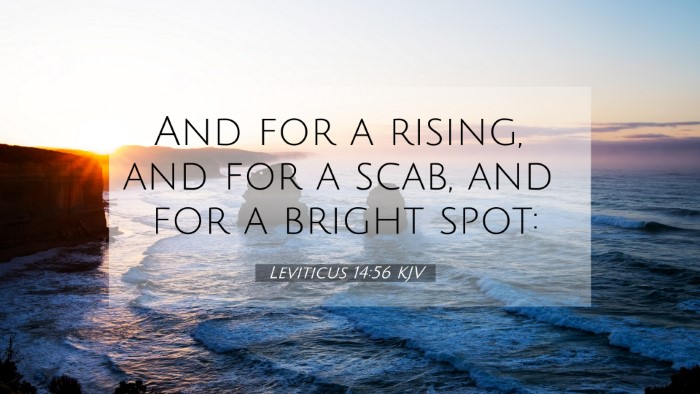Understanding Leviticus 14:56
Leviticus 14:56 states: "And for the leprous person, the priest shall command them to take for him who is to be cleansed two live clean birds and cedarwood and scarlet yarn and hyssop." This verse outlines part of the ritual for a person recovering from leprosy, directing the priest to use specific items for the cleansing process.
Summary of Insights from Public Domain Commentaries
This section gathers insights from renowned Biblical commentators, including Matthew Henry, Albert Barnes, and Adam Clarke, to provide a comprehensive understanding of this verse.
Matthew Henry's Commentary
Matthew Henry notes that the rituals for cleansing a leprous person emphasize the seriousness of sin and impurity in the ancient context. The use of live birds symbolizes both life and sacrifice, representing the need for atonement and the transformative power of God. The cedarwood, scarlet yarn, and hyssop represent a blend of strength, purification, and the binding nature of redemption.
Albert Barnes' Commentary
Albert Barnes emphasizes the practicality of the instructions given to the priests. He suggests that the inclusion of specific materials (birds, cedarwood, scarlet yarn, and hyssop) is indicative of the thoroughness required in ritual cleansing. Barnes points out that these elements also hold spiritual significance, serving as a foreshadowing of Christ’s sacrificial death, which ultimately cleanses believers from sin.
Adam Clarke's Commentary
Adam Clarke expands on the symbolic meanings of the materials used in this ritual. He describes the hyssop as an agent of purification, commonly used in the Passover and ritual cleansing, and notes the importance of the priest's role in mediating the cleansing process. Clarke connects the act of cleansing through these rituals to the broader theme of restoration and renewal seen throughout Scripture.
Bible Cross-References
This verse resonates with several other Bible verses that highlight themes of healing, cleansing, and atonement:
- Numbers 19:6 - Discusses the use of hyssop in purification rituals.
- Luke 17:14 - Jesus instructs lepers to present themselves to the priests for cleansing.
- Psalm 51:7 - "Purge me with hyssop, and I shall be clean; wash me, and I shall be whiter than snow."
- Matthew 8:3 - Jesus cleanses a man with leprosy, demonstrating His authority over diseases.
- James 5:16 - Confession and healing intertwined, emphasizing the role of faith in restoration.
- Hebrews 9:19 - References the sprinkling of blood and cleansing as part of the Mosaic Law.
- 1 Peter 2:24 - Connects Jesus' sacrifice with spiritual healing and cleansing from sin.
Thematic Connections
The ritual purification outlined in Leviticus 14:56 showcases intricate connections within the Scriptures, particularly between Old Testament law and the New Testament teachings about healing and redemption. The symbolism inherent in the materials used serves as an early template of the cleansing available through Christ's atonement.
Linking Bible Scriptures
The thematic connections between Bible verses, especially pertaining to purification, provide rich material for understanding the broader narrative of Scripture. By examining these verses, believers can uncover deeper spiritual truths and the consistent message of God's desire to restore.
Tools for Bible Cross-Referencing
For those seeking to explore connections between Bible verses, utilizing a Bible concordance or a Bible cross-reference guide can be invaluable. These resources help in identifying related themes and provide pathways for more in-depth study.
Conclusion
Leviticus 14:56 serves not only as an instruction for ancient rituals but also as a reminder of the ongoing need for spiritual cleansing and the hope found in God’s redemptive plan. By cross-referencing this verse with others, believers can gain a clearer understanding of their faith and the connection of God’s word throughout the Bible.



